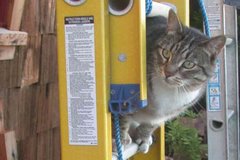<H2>A few days in </H2>
<ul>
<li>The R/V Tangaroa was constructed in 1991 in Bergen Norway. Below is the plaque that is mounted on the deck near where people board the ship. (I will add the photos when I can. Someone was using the computer that earlier let me attach photos to my blog. For now, I am emailing this post to my blog.</li>
DSC_0298.jpg
<li>Here is the gangplank shortly before it was hoisted prior to our departure. </li>
DSC_0301.jpg
<li>Here is the ship's bell, located on the foredeck. One needs to get permission from the bridge to access the foredeck since no science is conducted there. I had permission from Captain Evan. </li>
DSC_0271.jpg
<li>We had to bring lots of equipment aboard the ship prior to our cruise. Here is a photo of use loading the shipping container that we use as a core curation facility. We split and describe the cores in this container (sometimes called a "van). </li>
DSC_0091.jpg
<li>Here is the view from the ship as we left port in Wellington. </li>
DSC_0304.jpg
<li>We started coring in the region of Cook's Strait, the southernmost region of our planned coring sites. This region of the margin is complicated due to high tidal currents in the strait, fluvial input, and a plethora of fault trigger sources. There are many strike-slip faults that trend across the strait, in addition to the megathrust and faults in the accretionary prism. These sites would be important to work out the earthquake story in any trench cores further to the north. </li>
<li>These sites were not very successful due to their short recovered lengths. The R/V Tangaroa was initially designed for a fishing research institution, not for coring. It has since been retrofitted for various other oceanographic research studies, including coring. The coring is conducted along the starboard side of the ship, with a railroad track system. The longest cores that could be collected are 8 meters. It is not easy to take 8 meter cores, so the functionally maximum length is 6 meters. Most of these initial cores were between 1 and 2 meters long. They did not have coarse turbidites, but might have muddy turbidites (that are not visible to the eye and require CT scans to identify). </li>
<li>Here is a photo of Dr. Alan Orpin helping receive the first Piston Core (TAN1613-2) aboard the ship. Note all the safety gear. As for all cruises that I have participated on, safety is the most important thing. Sure, we all want to get the best data and conduct the best science, but that cannot be done when people get hurt. So we follow the strictest safety guidelines at all times while aboard the ship. There is a long list of things that we can and must do and everyone participates in an induction training prior to leaving port. We conduct regular training drills to make sure that everyone is always ready to take action if necessary. The ship's crew is trained for all conceivable situations and they are trained to use the appropriate equipment when necessary. The science crew knows that they must also be ready to help in the event the ship's crew makes that request. Needless
to say, we are very excited to get this first core aboard the ship. I will show photos of what we do with the core later.</li>
DSC_0549.jpg
</ul>
Sunday, November 13, 2016
Subscribe to:
Post Comments (Atom)


No comments:
Post a Comment